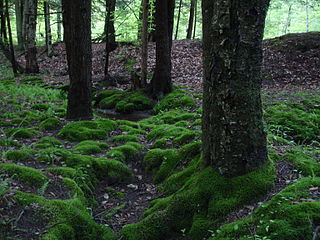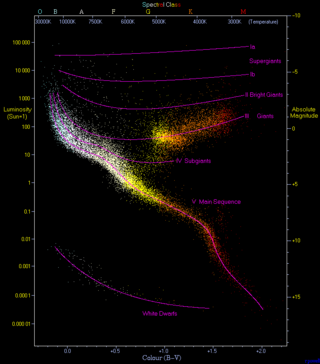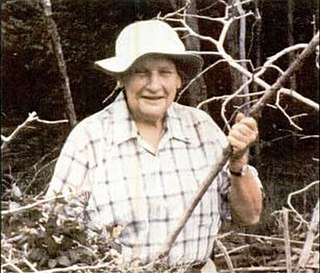Related Research Articles

Pollen is a powdery substance produced by most types of flowers of seed plants for the purpose of sexual reproduction. It consists of pollen grains, which produce male gametes.

Forensic palynology is a subdiscipline of palynology, that aims to prove or disprove a relationship among objects, people, and places that may pertain to both criminal and civil cases. Pollen can reveal where a person or object has been, because regions of the world, countries, and even different parts of a single garden will have a distinctive pollen assemblage. Pollen evidence can also reveal the season in which a particular object picked up the pollen. Recent research into forensic palynology has seen advancements in DNA barcoding from pollen, to the level of singular pollen molecules, allowing DNA profiles to be created from singular palynomorphs, streamlining the efficiency and accuracy of taxonomic identification.

Conifers are a group of cone-bearing seed plants, a subset of gymnosperms. Scientifically, they make up the division Pinophyta, also known as Coniferophyta or Coniferae. The division contains a single extant class, Pinopsida. All extant conifers are perennial woody plants with secondary growth. The great majority are trees, though a few are shrubs. Examples include cedars, Douglas-firs, cypresses, firs, junipers, kauri, larches, pines, hemlocks, redwoods, spruces, and yews. As of 2002, Pinophyta contained seven families, 60 to 65 genera, and more than 600 living species.

Peat is an accumulation of partially decayed vegetation or organic matter. It is unique to natural areas called peatlands, bogs, mires, moors, or muskegs. Sphagnum moss, also called peat moss, is one of the most common components in peat, although many other plants can contribute. The biological features of sphagnum mosses act to create a habitat aiding peat formation, a phenomenon termed 'habitat manipulation'. Soils consisting primarily of peat are known as histosols. Peat forms in wetland conditions, where flooding or stagnant water obstructs the flow of oxygen from the atmosphere, slowing the rate of decomposition. Peat properties such as organic matter content and saturated hydraulic conductivity can exhibit high spatial heterogeneity.

A bog body is a human cadaver that has been naturally mummified in a peat bog. Such bodies, sometimes known as bog people, are both geographically and chronologically widespread, having been dated to between 8000 BC and the Second World War. The unifying factor of the bog bodies is that they have been found in peat and are partially preserved; however, the actual levels of preservation vary widely from perfectly preserved to mere skeletons.

Mosses are small, non-vascular flowerless plants in the taxonomic division Bryophytasensu stricto. Bryophyta may also refer to the parent group bryophytes, which comprise liverworts, mosses, and hornworts. Mosses typically form dense green clumps or mats, often in damp or shady locations. The individual plants are usually composed of simple leaves that are generally only one cell thick, attached to a stem that may be branched or unbranched and has only a limited role in conducting water and nutrients. Although some species have conducting tissues, these are generally poorly developed and structurally different from similar tissue found in vascular plants. Mosses do not have seeds and after fertilisation develop sporophytes with unbranched stalks topped with single capsules containing spores. They are typically 0.2–10 cm (0.1–3.9 in) tall, though some species are much larger. Dawsonia, the tallest moss in the world, can grow to 50 cm (20 in) in height. There are approximately 12,000 species.

Palynology is the study of microorganisms and microscopic fragments of mega-organisms that are composed of acid-resistant organic material and occur in sediments, sedimentary rocks, and even some metasedimentary rocks. Palynomorphs are the microscopic, acid-resistant organic remains and debris produced by a wide variety of plants, animals, and Protista that have existed since the late Proterozoic.
Sir Harry Godwin, FRS was a prominent English botanist and ecologist of the 20th century. He is considered to be an influential peatland scientist, who coined the phrase "peat archives" in 1981. He had a long association with Clare College, Cambridge.
Paul Bigelow Sears was an American ecologist and writer.
This page provides a glossary of plant morphology. Botanists and other biologists who study plant morphology use a number of different terms to classify and identify plant organs and parts that can be observed using no more than a handheld magnifying lens. This page provides help in understanding the numerous other pages describing plants by their various taxa. The accompanying page—Plant morphology—provides an overview of the science of the external form of plants. There is also an alphabetical list: Glossary of botanical terms. In contrast, this page deals with botanical terms in a systematic manner, with some illustrations, and organized by plant anatomy and function in plant physiology.
Valerie Hall (1946-2016) was a Professor in Palaeoecology at Queen's University Belfast until her retirement in 2010, after which she remained a Professor Emerita. She gained a 2:2 in botany at Queen's University Belfast in 1968 and a PhD in Palaeoecology in 1989. She has produced a number of publications of which the best known may be Flora Hibernica, which she co-wrote along with J. Pilcher and published in 2001.

The Hertzsprung–Russell diagram is a scatter plot of stars showing the relationship between the stars' absolute magnitudes or luminosities and their stellar classifications or effective temperatures. The diagram was created independently in 1911 by Ejnar Hertzsprung and by Henry Norris Russell in 1913, and represented a major step towards an understanding of stellar evolution.

Suillus spraguei is a species of fungus in the family Suillaceae. It is known by a variety of common names, including the painted slipperycap, the painted suillus or the red and yellow suillus. Suillus spraguei has had a complex taxonomical history, and is also frequently referred to as Suillus pictus in the literature. The readily identifiable fruit bodies have caps that are dark red when fresh, dry to the touch, and covered with mats of hairs and scales that are separated by yellow cracks. On the underside of the cap are small, yellow, angular pores that become brownish as the mushroom ages. The stalk bears a grayish cottony ring, and is typically covered with soft hairs or scales.

Lucy May Cranwell was a New Zealand botanist responsible for groundbreaking work in palynology. Cranwell was appointed curator of botany at Auckland Museum in 1929, when she was 21 years old. As well as her work on ancient pollen samples she was responsible for encouraging a love of botany in a generation of Auckland children.
Estella Bergere Leopold was an American paleobotanist and a conservationist. As a researcher in the United States Geological Survey, she aided in uncovering records of plant life from the Miocene around the Eniwetok and Bikini Atolls in the southern Pacific Ocean and from the Cenozoic era in the Rocky Mountains. As a professor of botany and forest sciences at the University of Washington, she directed the Quaternary Research Center, researched the forest history of the Pacific Northwest, and collaborated with Chinese paleobotanists. Leopold's work as a conservationist included taking legal action to help save the Florissant Fossil Beds in Colorado, and fighting pollution. She was the daughter of Aldo Leopold.
Margaret Bryan Davis was an American palynologist and paleoecologist, who used pollen data to study the vegetation history of the past 21,000 years. She showed conclusively that temperate- and boreal-forest species migrated at different rates and in different directions while forming a changing mosaic of communities. Early in her career, she challenged the standard methods and prevailing interpretations of the data and fostered rigorous analysis in palynology. As a leading figure in ecology and paleoecology, she served as president of the Ecological Society of America and the American Quaternary Association and as chair of the Department of Ecology, Evolution and Behavior at the University of Minnesota. In 1982 she was elected to the National Academy of Sciences and, in 1993, received the Eminent Ecologist Award from the Ecological Society of America.

Kathleen Bever Blackburn, (1892–1968) was a British botanist best remembered for the 1923 discovery that plant cells have sex chromosomes. Her principal contributions were in plant cytology and genetics. She was also a pioneer of pollen analysis. She taught botany at Armstrong College, Durham University from 1918 to 1957.
Mabel Phyllis Barron was an English designer, known for her textile printing workshop with Dorothy Larcher. These textiles are ‘noted for the assurance and originality of the designs, their distinctive and subtle colouring, and the quality of the materials selected’

Cornelia Clermont Cameron was an American geologist who researched peat as a soil additive and energy source.

Harry John Betteley Birks is a botanist and emeritus professor at the University of Bergen and University College London. He is best known for his work on the development of quantitative techniques in Quaternary palaeoecology. He has researched the vegetational and environmental history over the past 10–20,000 years in many parts of the world, including Fennoscandia, UK, Minnesota, the Yukon, Siberia, and Tibet.
References
- 1 2 "Ancestry.Com". Newport, Phyllis D.
- ↑ "Paul Bigelow Sears (1891-1990): eminent scholar, ecologist and conservationist. - Free Online Library". www.thefreelibrary.com. Retrieved 2018-04-14.
- 1 2 3 Draper, Phyllis. A Demonstration of the Technique of Pollen Analysis.
- ↑ Draper, Phyllis. "A Comparison of Pollen Spectra of Old and Young Bogs in the Erie Basin" (PDF). Archived from the original (PDF) on 2010-06-24.
- ↑ "Thirty-Seventh Annual Commencement". Commencement Day Program, University of Oklahoma. June 4, 1929.
- 1 2 Draper, Phyllis. "A Comparison of Pollen Spectra of Old and Young Bogs in the Erie Basin" (PDF). Archived from the original (PDF) on 2010-06-24.
- ↑ Shane, Linda (December 2009). "Paul B. Sears' Contributions to the Development of Paleoecology" (PDF). The Ohio Journal of Science. 109: 76–77. hdl:1811/52467.
- ↑ "Oklahoma Alumni News" (PDF). The Sooner Magazine.
- ↑ "Pine Pollen Carried 450 Miles By Wind". The Leaf-Chronicle. Feb 13, 1950.